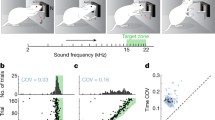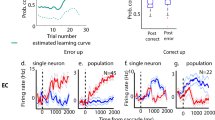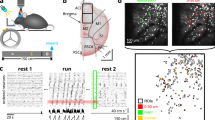Abstract
Single-cell recording was conducted in the hippocampus of rats that performed a spontaneous alternation task in a modified T-maze. In the central arm of the maze, 4 out of 45 cells (8%) were found that fired selectively depending on which turn the animals would take. This result is in disagreement with a previous study in which two-thirds of cells (22 out of 33) showed a clear bias for direction of turns. The interpretation was that the cells coded information of episodic memory. Our results do not support this hypothesis. Interestingly, over the course of training, an increasing number of cells were found that fired in correlation with the rats’ movements. It is proposed that these cells associate egocentric motor information with allocentric spatial information rather than encode episodic memory.





Similar content being viewed by others
References
Ainge JA, Wood E (2003) Excitotoxic lesions of the hippocampus impair performance on a continuous alternation T-maze task with short delays but not with no delay. Society for Neuroscience 24th Annual Meeting, New Orleans, Program no. 91.1. Society for Neuroscience, Washington DC. Available online via 2003 Abstract Viewer/Itinerary Planner: http://sfn.scholarone.com/tin2003/
Allers K, Ruskin D, Bergstrom D, Freeman L, Ghazi L, Tierney P, Walters J (2002) Multisecond periodicities in basal ganglia firing rates correlate with theta bursts in transcortical and hippocampal EEG. J Neurophysiol 87:1118–1122
Barnes CA, Suster MS, Shen J, McNaughton BL (1997) Multistability of cognitive maps in the hippocampus of old rats. Nature 388:272–275
Bolhuis JJ, Reid IC (1992) Effects of intraventricular infusion of the N-methyl-d-aspartate (NMDA) receptor antagonist AP5 on spatial memory of rats in a radial arm maze. Behav Brain Res 47:151–157
Bower M, Euston D, Roop R, Gebara N, McNaughton B (2002) How an ambiguous sequence is learned determines how the hippocampus encodes it. Society for Neuroscience Meeting, Orlando Neurosci 23rd Annual Meeting, Orlando, Program no. 678.13. Society for Neuroscience, Washington DC. Available online via 2002 Abstract Viewer/Itinerary Planner: http://sfn.scholarone.com/tin2002/
Butelman ER (1990) The effect of NMDA antagonists in the radial arm maze task with an interposed delay. Pharmacol Biochem Behav 35:533–536
DeCoteau W, Courtemanche R, Kubota Y, Graybiel A (2002) Anti-phase theta-range oscillations in striatum and hipocampus recorded in rats during T-maze task performance. Society for Neuroscience 23rd Annual Meeting, Orlando, Program no. 765.6. Society for Neuroscience, Washington DC. Available online via 2002 Abstract Viewer/Itinerary Planner: http://sfn.scholarone.com/tin2002/
Eichenbaum H (2000) A cortical–hippocampal system for declarative memory. Nat Rev 1:41–50
Fenton AA, Csizmadia G, Muller RU (2000) Conjoint control of hippocampal place cell firing by two visual stimuli. I. The effects of moving the stimuli on firing field positions. J Gen Physiol 116:191–209
Floresco SB, Seamans JK, Phillips AG (1997) Selective roles for hippocampal, prefrontal cortical, and ventral striatal circuits in radial-arm maze tasks with or without a delay. J Neurosci 17:1880–1890
Foster TC, Castro CA, McNaughton BL (1989) Spatial selectivity of rat hippocampal neurons: dependence on preparedness for movement. Science 244:1580–1582
Frank LM, Brown EN, Wilson M (2000) Trajectory encoding in the hippocampus and entorhinal cortex. Neuron 27:169–178
Gaffan D (1998) Idiothetic input into object-place configuration as the contribution to memory of the monkey and human hippocampus: a review. Exp Brain Res 123:201–209
Gerstner W, Abbott L (1997) Learning navigational maps through potentiation and modulation of hippocampal place cells. J Comput Neurosci 4:79–94
Gothard KM, Skaggs WE, McNaughton BL (1996) Dynamics of mismatch correction in the hippocampal ensemble code for space: interaction between path integration and environmental cues. J Neurosci 16:8027–8040
Harris K, Henze D, Csicsvari J, Hirase H, Buzsáki G (2000) Accuracy of tetrode spike separation as determined by simultaneous intracellular and extracellular measurements. J Neurophysiol 84:401–414
Hollup SA, Molden S, Donnett JG, Moser MB, Moser EI (2001) Accumulation of hippocampal place fields at the goal location in an annular watermaze task. J Neurosci 21:1635–1644
Hölscher C, Schmidt WJ (1994) Quinolinic acid lesion of the rat entorhinal cortex pars medialis produces selective amnesia in allocentric working memory (WM), but not in egocentric WM. Behav Brain Res 63:187–194
Hölscher C, Jacob W, Mallot H (2003) Reward modulates neuronal activity in the hippocampus of the rat. Behav Brain Res 142:181–191
Jeffery KJ (1998) Learning of landmark stability and instability by hippocampal place cells. Neuropharmacology 37:677–687
Jeffery K (2001) Plasticity of the hippocampal cellular representation of space. In: Hölscher C (ed) Neuronal mechanisms of memory formation: concepts of long term potentiation and beyond. Cambridge University Press, Cambridge, Chapter 4
Lavoie A, Mizumori S (1994) Spatial, movement- and reward-sensitive discharge by medial ventral striatum neurons of rats. Brain Res 638:157–168
Lenck-Santini, P, Save, E, Poucet, B (2001) Place-cell firing does not depend on the direction of turn in a Y-maze alternation task. Eur J Neurosci, 13:1055–1058
McDonald RJ. White NM (1994) Parallel information processing in the water maze: evidence for independent memory systems involving dorsal striatum and hippocampus. Behav Neural Biol 61:260–270
McNaughton B, Barnes C, Gerrard J, Gothard K, Jung M, Knierim J, Kudrimoti H, Qin Y, Skaggs W, Suster M, Weaver K (1996) Deciphering the hippocampal polyglot: the hippocampus as a path integration system. J Exp Biol 199:173–185
Moser EI, Paulsen O (2001) New excitement in cognitive space: between place cells and spatial memory. Curr Opin Neurobiol 11:745–751
Nadel L, Eichenbaum H (1999) Introduction to the special issue on place cells. Hippocampus 9:341–345
O’Keefe J (1979) A review of the hippocampal place cells. Prog Neurobiol, 13:419–439
O’Keefe J, Recce ML (1993) Phase relationship between hippocampal place units and the EEG theta rhythm. Hippocampus 3:317–330
Packard MG, Knowlton BJ (2002) Learning and memory functions of the basal ganglia. Annu Rev Neurosci 25:563–593
Ragozzino KE, Leutgeb S, Mizumori SJ (2001) Dorsal striatal head direction and hippocampal place representations during spatial navigation. Exp Brain Res 139:372–376
Rasmussen M, Barnes CA, McNaughton BL (1989) A systematic experiment of cognitive mapping, working memory and temporal discontiguity theories of hippocampal function. Psychobiology 17:335–348
Rawlins JNP (1985) Association across time: the hippocampus as a temporary memory store. Behav Brain Sci 8:479–496
Redish AD, Battaglia FP, Chawla MK, Ekstrom AD, Gerrard JL, Lipa P, Rosenzweig ES, Worley PF, Guzowski JF, McNaughton BL, Barnes CA (2001) Independence of firing correlates of anatomically proximate hippocampal pyramidal cells. J Neurosci 21:RC134
Shapiro LM, Caramanos Z (1990) NMDA antagonist MK-801 impairs acquisition but not performance of spatial working and reference memory. Psychobiology 2:231–243
Shapiro M, Eichenbaum H (1999) Hippocampus as a memory map: synaptic plasticity and memory encoding by hippocampal neurons. Hippocampus 9:365–384
Tulving E, Kapur S, Craik F, Moskovitch M, Houle S (1994) Hemispheric encoding/retrieval asymmetry in episodic memory: positron emission tomography findings. Proc Natl Acad USA Sci 91:2016–2020
Vnek N, Rothblat LA (1996) The hippocampus and long-term object memory in the rat. J Neurosci 16:2780–2787
Wise SP, Murray EA, Gerfen CR (1996) The frontal cortex-basal ganglia system in primates. Crit Rev Neurobiol 10:317–56
Wood ER, Dudchenko PA, Robitsek RJ, Eichenbaum H (2000) Hippocampal neurons encode information about different types of memory episodes occurring in the same location. Neuron 27:623–33
Zola-Morgan S, Squire LR, Amaral DG (1986) Human amnesia and the medial temporal region: enduring memory impairment following a bilateral lesion limited to CA1. J Neurosci 6:2950–2967
Author information
Authors and Affiliations
Corresponding author
Rights and permissions
About this article
Cite this article
Hölscher, C., Jacob, W. & Mallot, H.A. Learned association of allocentric and egocentric information in the hippocampus. Exp Brain Res 158, 233–240 (2004). https://doi.org/10.1007/s00221-004-1896-z
Received:
Accepted:
Published:
Issue Date:
DOI: https://doi.org/10.1007/s00221-004-1896-z




